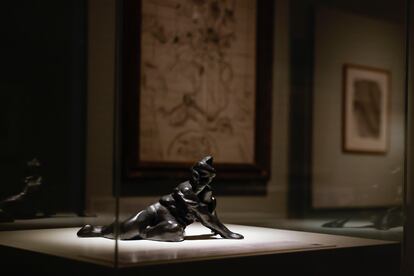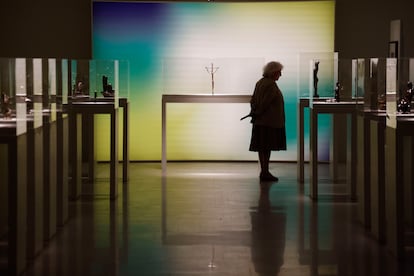Henri Matisse also sculpted. “I like modeling as much as painting, I have no preference. The search is the same, so when I get tired of one half-step to another,” he said the Frenchman, one of the greatest artists of the 20th centuryin a letter dated 1913. Picking up the echo of that phrase, heThe Canal Foundation presented this Tuesday in Madrid the exhibition Matisse. Metamorphosis. Sculptures and drawingsa very complete sample of that other three-dimensional side of the artist, which can be seen for free until January 12.
“It is an exhibition never seen before in Spain, which shows the multiple character of the artist and delves into many of his facets,” comments Aymeric Jeudy, director of the Matisse Museum in Nice, who has been accompanied in the presentation by Sandra Gianfreda, curator of the Kunsthaus Zürich; Eva Tormo, managing director of the Canal Foundation; Cristian Ruiz Orfila, director of Art and Culture of the foundation, and Popy Venzal, associate curator of the exhibition, which has been organized in collaboration with the Matisse museum in Nice and the Kunsthaus Zürich museum, and which has the support of Manifesto Expo .
For Venzal there are three reasons why this sculptural facet of Matisse is so unknown. “The first is the small size of the sculptures,” he says. It is true: those that can be seen in the Canal sample vary between eight and 40 centimeters, an unspectacular format. “The second, that there are very few.” Specifically, 84, of which 33 can be seen in the Madrid room. “Finally, many times these sculptures are considered studies, attempts by the artist, not finished works,” says Venzal, who, however, is completely opposed to this idea. “If they are considered studies It is because on the surface you can see the artist’s workthe physical marks of its modeling in the clay,” he explains, “although this is consciously. “He wants the mark of his work to be seen.” It is similar to how he painted, and demonstrates the relevance of the artist’s initial phrase: “The search is the same.”

Blanca Millez (EFE)
The exhibition is divided into three rooms. The first is dedicated to smaller sculptures. All of them, summarized in three great poses: crouching figures, reclining figures and figures with raised arms. A room that opens with the dialogue between a sculpture by Matisse and another from his friend Aristide Mailloltwo naked women hugging their legs. Venzal returns to the thick line, to the wounds on the surface. “We see in all the sculptures modeling gestures that make the light reflect in a vivid way. And the accident is assumed,” he explains, pointing to a female figure who lost an arm when Matisse took the clay model out of his pocket.
Except for one, all the sculptures are female. The reclining figures demonstrate the important “erotic force, and the thought about death, relevant in his work“says Venzal, who explains how the artist went from one medium to another by pointing to a sculpture of his wife, Amelianext to a still life drawn by the artist in which, next to a vase with flowers, that same sculpture appears. The exhibition also has drawings, lithographs and a canvas by the artist. And in several of these works there are small sculptures, which give this supervening human presence a humble scale. To complete the exhibition, photographs from artistic magazines are exhibited that at the beginning of the 20th century made models pose with an erotic dimension.
“It is a posture full of ambiguity, a figure of intimacy and iconography linked to pain, to a spiritual dimension,” explains the curator about the figures with raised arms. That first room closes, if we talk about bodies with arms raisedwith the figure of figures: a crucified Christ, stretched, serene, appeased, “a fragile body but without a trace of pain”, in the curator’s words, which Matisse created while working in the Rosary chapel in Vence in 1949.

The second room is dedicated to the portrait. In addition to individual sculptures, there are series: several medallions with the effigy of his first companion, Caroline Joblaud. Three busts of Henriette Derricarrère, the main model who worked with Matisse for eight years; or the Janette, perhaps his best-known sculptural work, three busts of a young woman that range from realism to abstraction and in which the hair curls until it looks like a bouquet of flowers. The last, smaller room is dedicated to sketches and drawings, and ends with a video (borrowed from the Gauguin Museum) on the lost wax bronze casting technique.
“Admitting that there is a certain richness in some of my canvases, I would not hesitate to abandon painting if my expression had to manifest itself in another way.” These are words that the French painter said in 1929. “To express the form I sometimes resort to sculpture, which allows me, instead of standing in front of a flat surface, to rotate around the object and get to know it better.” Now visitors can revolve around these objects to get to know them better and, incidentally, the great artist who sculpted them.
Babelia
The literary news analyzed by the best critics in our weekly newsletter

